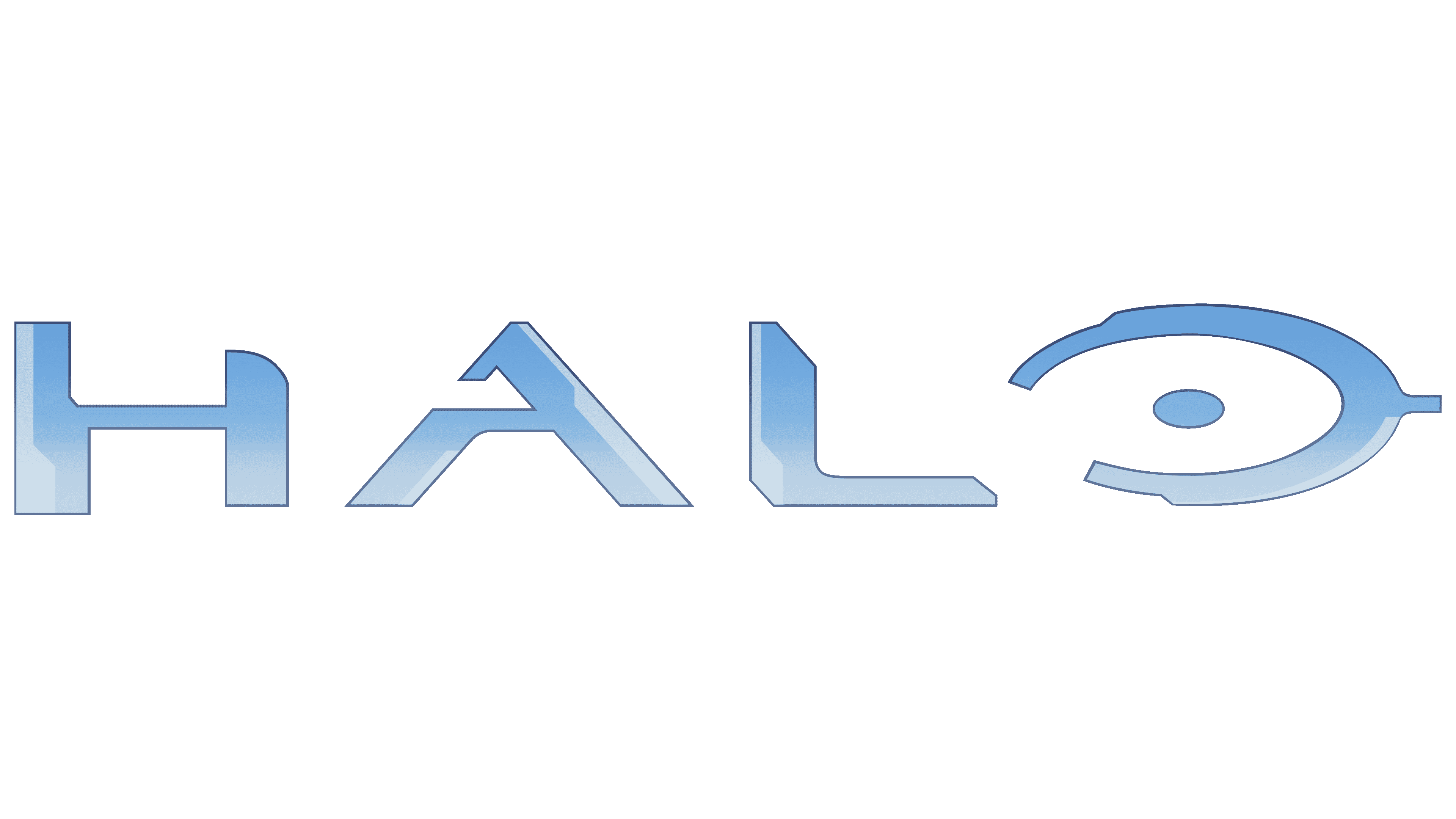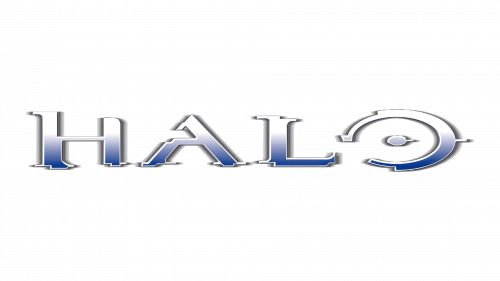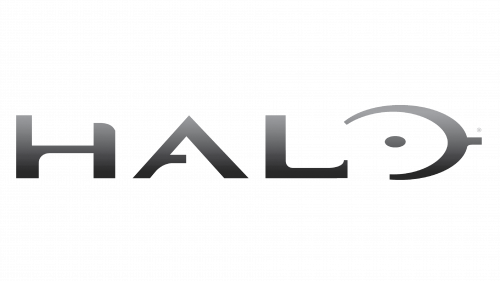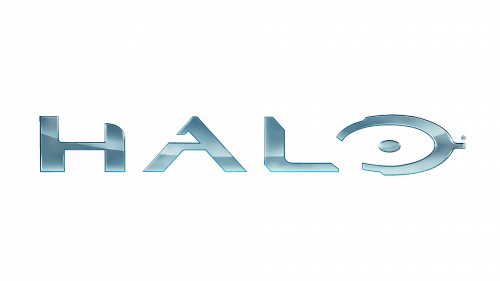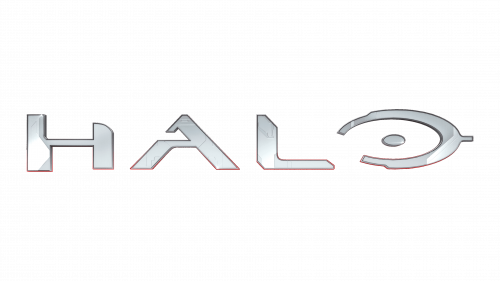Halo Logo
The Halo series is one of the well-known shooter series of all time that made history. The game tells about the confrontation between people and the Covenant of aliens in order to save their own planet. Due to an unsuccessful movement in space, the ship of the main character falls on a giant Halo – a ring of titanic size, on which the artificial world is located. Master Chief will have to unravel the secret of the Halo and get out of it before the aliens get hold of information regarding the location of the Earth.
Meaning and History
The first game became iconic for a generation of gamers, and for good reason. Studio Bungie, now known for the Destiny series, once brought the shooter genre and its console representatives in particular to a new level. But in 1997, few people knew about it, when the development of a strategy game based on a new intellectual property, Halo, started. It was exclusive to Macintosh platforms, and in 1999, Steve Jobs presented the project at Macworld Expo. In 2000, Bungie was bought and became part of Microsoft Game Studios and a year later, the game came out and became a sensation.
What is Halo?
Halo is a fantasy first-person shooter originally released for the Xbox and later ported to the PC. In the early years, the original Xbox didn’t have a decent library of games.
2001 – 2010
For the logo from 2001, “Halo” is spelled out in stark, blocky letters that convey solidity and presence. The characters are broad and imposing, with a particular emphasis on the stylized “A,” whose pointed peak might be reminiscent of a Spartan helmet, suggesting an element of ancient warfare mixed with futuristic combat. The cut in the “O” adds an air of mystery and could be seen as a reference to a scope or an aerial view of a halo in space, central to the game’s plot.
2001 – 2004
The initial duo of segments showcased a logo bearing the word “HALO” with irregular lettering. These characters displayed depth through shadows and a gradient transition, fading from a pristine white upper portion into a deep blue lower segment. Distinctive flairs were evident on each letter, adding a unique touch. Intriguingly, the “O” in the title wasn’t just a simple circle. Instead, it was creatively left open with a petite circle and a horizontal line situated within, adding to the design’s distinctiveness and emphasizing its individuality. This logo was a blend of traditional elements with innovative twists, embodying the essence of the brand.
2004 – 2007
When the game first came out, it was accompanied by a logo that was a stylized name of the game. It had a metallic look with a white, gray, and blue gradient. The letters were wide and had a grey shadow. The font itself had broken and sharp edges, with letters “A” and “O” having opened center. There was also a small circle inside the “O”, which made it look as if it is a shooting target.
2007 – 2010
The game had its logo updated with a release of a new series. The most noticeable change was done to the color of the wordmark. It was a dark shade of blue mixed in with black and light blue colors. This color scheme was a good reflection of the game’s theme. There was no more shadow, but the letters had a border that gave them a 3D look. Some of the edges and lines of the letters looked uneven and resembled broken bricks. Otherwise, the font closely resembled the original.
2009
In the offshoot game, “Halo Wars”, the emblem underwent noticeable alterations, resulting in a much subdued color palette. The logo adopted a gradient technique, transitioning from a soft, almost ethereal white at the base to a muted blue at its peak. While the typeface largely retained its essence from previous iterations, subtle distinctions emerged. In contrast to the “Halo 3” symbol, this rendition utilized delicate outlining, lending a more svelte appearance to the letter edges. This design choice was perhaps an attempt to evoke a different atmosphere, emphasizing the strategic nature of this game compared to its more action-packed counterparts.
2010 – 2012
A new update to the logo brought on more drastic changes. The name of the game was used for the logo once more and was written using wide, capital letters, but this time the lines were smooth. The opening in the letter “A” was done in a different place and “O” had an even larger opening where it would otherwise touch the “L”. The color scheme was changed to a black and gray gradient.
2010 – Today
For еру logo from 2010, the “Halo” text retains its boldness but with a subtle shift towards a more refined typeface. The letters appear more streamlined and modern, reflecting the evolution of the game series over time. The “A” and “O” continue to be distinctive, the former maintaining its peak, a consistent element that brands the series, while the latter’s open circle still suggests a scope consistent with the targeting and precision required in gameplay. This iteration of the logo retains the foundational design elements while embracing a sleeker, more contemporary look that speaks to the game’s ongoing innovation and expansion.
2010 – 2013
The new Halo logo was a mix of the previous and original wordmark, where letters “A” and “O” looked more like the originals, but the smooth lines of the previous version were preserved. The color scheme was changed back to different shades of blue that filled the text with a gradient.
2013
In 2013, a fresh logo emerged for “Halo: Spartan Assault,” tailored for Windows Phone and Windows 8 platforms. Eschewing the traditional gradient, the design opted for a more restrained, dual-tone gray palette. The transition between the two shades was sharp, with the lighter hue dominating the core of the letters and the darker one emphasizing the shadows, lending an appearance of depth. Despite this shift towards a more two-dimensional aesthetic, the typeface remained consistent with its predecessors. The designers’ choice perhaps aimed at preserving brand recognition while aligning with the sleek and modern interface of the platforms it was introduced for.
2014
In 2014, with the release of “Halo: The Master Chief Collection,” a refreshed logo graced the scene. This iteration showcased a serene blue hue, enriched with subtle variations in tones, resembling the dappling of light. Radiant accents illuminated the logo, infusing it with a shimmering quality. It evoked the sensation that the typography was not just polished to a mirror-like finish, but also emanated a soft luminosity from its core, making it both mesmerizing and memorable. This design choice seemed to encapsulate the ethereal and dynamic essence of the game, drawing players into its intricate universe.
2014 – 2016
Game designers stayed true to the original design. The redesign mainly focused on the colors, which now had shades of turquoise and gray. The 3D effect and smooth lines were kept the same.
2015 – Today
Just like the previous updates, the changes in the logo were minimal. It was only the color scheme that was updated to have shades of gray and white. The 3D border became even more defined and had some orange at the bottom.
2016 – 2019
“Halo Wars 2” and “Halo Infinite” for PC introduced a revamped logo, embracing a more streamlined aesthetic. The design maestros behind this iteration chose a dual-tone palette, melding pristine white with a lustrous silver. Intriguingly, every character is accentuated with a distinctive black border. This border, varying in its breadth, gives an illusion of depth, mimicking a shadow’s play. Instead of simplifying, this rendition heightens the three-dimensional allure, offering a more tactile and layered visual experience. This thoughtful detailing serves as a testament to the meticulous craftsmanship invested in the game’s overarching narrative and presentation.
2019 – 2021
In 2019, “Halo: The Master Chief Collection” unveiled a revamped logo. The erstwhile blue lettering gracefully transitioned to a golden hue. Craftsmen at the design helm employed a fusion of varied tints to impart a tangible depth to the emblem. Intriguingly, this iteration accentuated the upper portions with a deeper shade, while the lower and right facets of the characters shimmered in a brighter luminosity. Maintaining a nod to tradition, the central circle within the “O” made its prominent return. This deliberate juxtaposition of shades reflects the game’s intricate detailing and the meticulous attention it consistently receives from its creators.
2021 – Today
Upon launching “Halo Infinite” as part of the esteemed series, a freshly conceptualized logo made its debut. This emblem adhered to its roots, showcasing the iconic typeface and embracing the signature blue spectrum infused with gradient transitions. It’s apt to describe this design as a contemporary ode to time-honored traditions. The hues selected exude subtlety, seamlessly blending from one to the next. However, in a meticulous contrast, certain shadow elements have been distinctly demarcated, striking a balance between the familiar and the newly envisioned. The careful fusion of elements testifies to the game’s commitment to both heritage and innovation.
